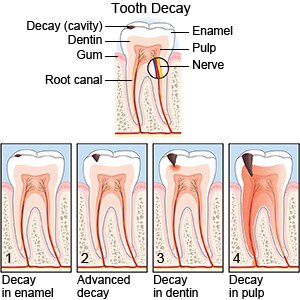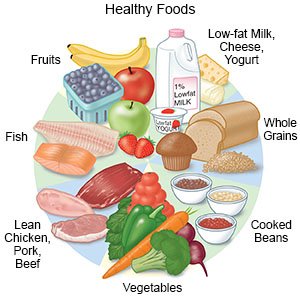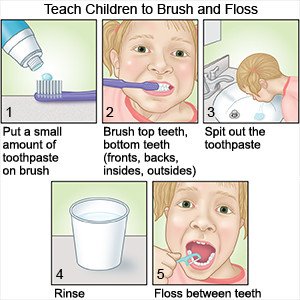Early Childhood Cavities
Medically reviewed by Drugs.com. Last updated on Aug 4, 2025.
What are early childhood cavities (ECC)?
ECC are holes or decay that form in or on your child's teeth. This usually happens before he or she is 6 years old. The cavities can start as soon as the tooth starts to erupt (push through the gum tissue). ECC is sometimes called night bottle mouth or baby bottle tooth decay. Cavities are caused by bacteria. The bacteria mix with carbohydrates from foods and create acids. The acids break down areas of enamel, which covers the outside of a tooth.
 |
What increases my child's risk for ECC?
- Soda, fruit juice, breast or cow's milk, or other sugary drinks during the day
- Sugary drinks that stay on your child's teeth while he or she sleeps
- Conditions such as enamel hypoplasia, high levels of certain bacteria, or tooth demineralization
What are the signs or symptoms of ECC?
The earliest signs are white spots along the gum line, near the upper front teeth. You may not be able to see these spots. Your child may not have any symptoms if cavities have just started to form. When cavities reach deeper parts of your child's tooth, he or she may have pain. Your child may also have any of the following:
- Pain when your child chews or eats hot or cold foods
- Chalky white, yellow, or brown tooth
- Gum swelling
How are ECC diagnosed?
The dentist will look at your child's teeth to check for signs of decay or cavities. He or she may also use x-rays to find cavities.
How are ECC treated?
Treatment is important, even in baby teeth. Healthy teeth at a young age will help your child have healthy teeth as an adult. Depending on your child's age, he or she may need any of the following:
- A fluoride treatment may be given during dental visits. Your child may use products with fluoride at home. Your child's dentist will tell you what kind of fluoride your child needs and how to use it.
- A filling may be placed in your child's tooth after the decayed portion is removed. The filling may help to protect your child's tooth from more decay.
- A root canal may be needed if the tooth is infected or the decay is severe.
How can I help my child prevent ECC?
- Bring your child to the dentist 2 times each year. Your child should start seeing a dentist when you see the first tooth, or by 1 year of age. A dentist can find and treat problems early. This may help prevent dental cavities. The dentist can give your child a fluoride treatment to help prevent cavities. Your child's dentist may prescribe a fluoride supplement if your local water supply has a low fluoride level.
- Do not put your child to bed or nap time with a bottle. Hold your child while you feed him or her. Wipe you child's teeth with a clean washcloth after the feeding. Then put him or her down to sleep.
- Give your child healthy foods and drinks. Choose foods and drinks that are low in sugar. Read food labels to help you choose foods that are low in sugar. Limit candy, cookies, and soda. Do not dip your child's pacifier in sugar, syrup, or any other sweetened liquid.

- Limit fruit juice as directed. Fruit juice is high in sugar. Do not give your baby fruit juice in a bottle. Do not give your child fruit juice in a cup he or she can carry around during the day. Limit fruit juice to 4 ounces a day from 6 months to 1 year. Limit to 4 to 6 ounces a day from 1 year to 6 years.
- Teach your child to drink from a regular cup as early as possible. Your child should be able to drink from a cup by 12 months. A regular cup will make your child slow down to drink carefully. This means he or she will drink sugary liquids more slowly than from a bottle or sippy cup.
How do I brush my child's teeth?
- From birth to 1 year, use a clean washcloth to wipe your baby's gums. You can start brushing your baby's teeth as soon as they start to appear. Use a baby toothbrush with a soft head. Put a small amount (the size of a grain of rice) of fluoride toothpaste on the toothbrush. Go over the teeth with a washcloth to remove any remaining toothpaste. Brush 1 time each day.
- From 1 to 3 years, your child needs to have his or her teeth brushed 2 times each day. Brush your child's teeth with a children's toothbrush and water. Your child's healthcare provider may recommend that you brush his or her teeth with a small smear of toothpaste that contains fluoride. Make sure your child spits all of the toothpaste out. He or she does not need to rinse with water. The small amount of toothpaste that stays in your child's mouth can help prevent cavities.
- From 3 to 6 years, your child needs to have his or her teeth brushed with fluoride toothpaste 2 times each day. You should also floss your child's teeth 1 time each day. Brush for at least 2 minutes. Apply a pea-sized amount of toothpaste on the toothbrush. Make sure your child spits all of the toothpaste out. He or she does not need to rinse with water. The small amount of toothpaste that stays in your child's mouth can help prevent cavities.
 |
When should I seek immediate care?
- Your child has severe pain in his or her tooth or jaw.
- Your child has swelling in his or her jaw or cheek.
When should I call my child's dentist?
- Your child has a fever.
- Your child's tooth pain gets worse.
- You have questions or concerns about your child's condition or care.
Care Agreement
You have the right to help plan your child's care. Learn about your child's health condition and how it may be treated. Discuss treatment options with your child's healthcare providers to decide what care you want for your child. The above information is an educational aid only. It is not intended as medical advice for individual conditions or treatments. Talk to your doctor, nurse or pharmacist before following any medical regimen to see if it is safe and effective for you.© Copyright Merative 2025 Information is for End User's use only and may not be sold, redistributed or otherwise used for commercial purposes.
Further information
Always consult your healthcare provider to ensure the information displayed on this page applies to your personal circumstances.
